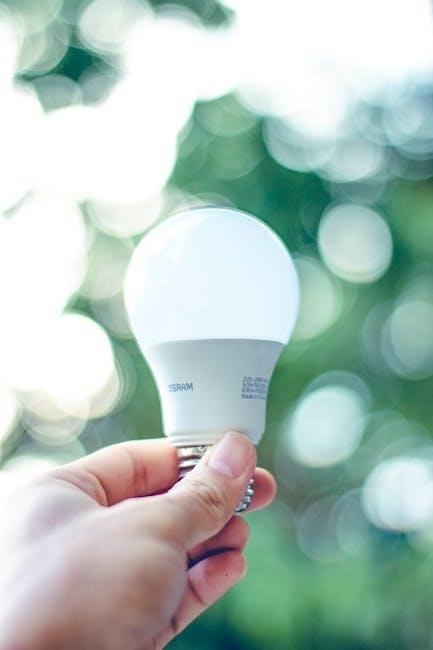Overview of Bokeh and Hvplot
Bokeh and Hvplot are popular Python libraries used for creating interactive visualizations.
They provide a high-level interface for drawing plots‚ charts‚ and graphs‚ making it easy to create web-based interactive plots.
Bokeh is a powerful library that targets modern web browsers for presentation‚ while Hvplot is built on top of Bokeh and provides a simpler interface.They are widely used in data science‚ scientific computing‚ and education for creating interactive visualizations.
The libraries are highly customizable‚ allowing users to tailor their plots to specific needs.
With their ability to create interactive visualizations‚ Bokeh and Hvplot have become essential tools for data scientists and researchers.
They can be used to create a wide range of visualizations‚ from simple plots to complex dashboards.
Overall‚ Bokeh and Hvplot are powerful libraries that make it easy to create interactive visualizations in Python.
Understanding the Bokeh Save Function
Basic Usage of the Save Function
The save function in Bokeh is used to export visualizations to various file formats‚ making it easier to share and document plots.
To use the save function‚ you need to import the necessary libraries‚ including bokeh.plotting and bokeh.io.
Then‚ you can create a plot using the figure function and add elements such as lines‚ circles‚ and text.
Once the plot is created‚ you can use the save function to export it to a file‚ specifying the filename and the output format. This makes it easy to share plots with others‚ either by sending them the file directly or by embedding the plot in a web page;
The save function is a powerful tool in Bokeh‚ allowing users to easily export and share their visualizations.
By using the save function‚ users can create a wide range of visualizations and share them with others in a variety of formats.
This flexibility makes the save function a valuable asset in data analysis and visualization.
Overall‚ the save function is an essential part of the Bokeh library‚ providing users with the ability to easily export and share their plots.

Exporting Bokeh Visualizations to PDF
Using the Export_SVGs Function
The Export_SVGs function is a useful tool for exporting Bokeh visualizations to SVG format‚ which can then be converted to PDF. This function allows users to specify the filename and other options for the exported SVG file. To use the Export_SVGs function‚ users need to import the necessary libraries and create a Bokeh plot. The plot can be customized with various options‚ such as title‚ axis labels‚ and legends. Once the plot is created‚ the Export_SVGs function can be called to export the plot to an SVG file. The resulting SVG file can be converted to PDF using other libraries or tools. The Export_SVGs function provides a convenient way to export Bokeh visualizations to a format that can be easily shared or printed. By using this function‚ users can create high-quality PDF files from their Bokeh plots. This function is particularly useful for creating reports or presentations.

Creating PDF Reports with Reportlab
Building the PDF with the Platypus Method
The Platypus method in Reportlab is used to build PDF documents by creating a story and adding elements to it‚ such as paragraphs‚ images‚ and tables. This method provides a simple and efficient way to generate complex PDF reports.
By using the Platypus method‚ users can create customized PDF reports that include Bokeh plots‚ text‚ and other elements‚ with full control over the layout and design of the document.
The process involves creating a story‚ adding elements to it‚ and then building the PDF document using the Platypus method‚ which can be used to generate reports‚ invoices‚ and other types of documents.
This approach allows for a high degree of customization and flexibility‚ making it a popular choice for generating PDF reports with Python.
With the Platypus method‚ users can create professional-looking PDF documents that include interactive Bokeh plots and other dynamic content.

Using Hvplot to Save Plots to PDF
Hvplot Show Function and Static Plots

Bokeh Server and Dynamic Plots
Launching the Bokeh Server and Enabling Dynamic Features
To launch the Bokeh server‚ you can use the bokeh serve command‚ which will start the server and make your visualizations available at a specified URL. The Bokeh server provides a range of dynamic features‚ including interactive plots‚ dashboards‚ and applications. By using the Bokeh server‚ you can create web-based visualizations that can be shared with others‚ and that provide a high level of interactivity. The server also supports real-time updates‚ allowing you to create visualizations that change and update in response to new data. This makes it ideal for applications such as monitoring and reporting‚ where data is constantly changing. Overall‚ the Bokeh server is a powerful tool for creating dynamic‚ web-based visualizations‚ and can be used to create a wide range of interactive and engaging applications. It is easy to use and provides a lot of functionality.




About the author